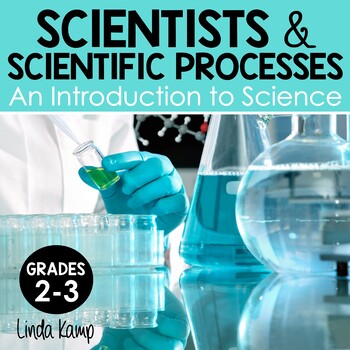Scientists & The Scientific Method, Scientific Processes | 2nd 3rd Grade Science
- Zip
What educators are saying
Also included in
- Scientists and the scientific method, science processes-This bundle includes everything you need to teach, practice, experiment, and assess 8-11 days of NGSS aligned lessons, depending on the number of experiments you do. All of the activities are included in both a printable version and in digitalPrice $27.00Original Price $34.00Save $7.00
- Teaching second grade science aligned with the Next Generation Science Standards is quite challenging without quality resources to guide you. These in-depth units address all 2nd grade NGSS topics and enable you to plan and teach high-engagement, three-dimensional science lessons. The six units in tPrice $105.00Original Price $132.00Save $27.00
- Teaching third grade science, aligned the Next Generation Science Standards, is quite challenging without quality resources to guide you. These in-depth science units address all the 3rd grade NGSS topics and enable you to plan and teach highly-engaging lessons that don’t take hours to plan becausePrice $106.00Original Price $132.00Save $26.00
Description
This resource is a complete science unit with engaging lessons and experiments to introduce second, third, and even fourth grade students to science, the scientific method, and other processes scientists use. Students learn the different areas of science, types of scientists and the jobs they do, science tools, science safety, and planning and conducting experiments using the scientific method.
Your students will enjoy ten high engagement lessons in a detailed teaching Power Point, science journal and center activities for each lesson, and 3 high interest science experiments that give students lab experience and build a foundation for your future science units.
CLICK HERE for a digital version of the student activities in this unit plus audio teaching slides.
Students experiment with buoyancy, solubility, and chemical reactions. These fun science experiments give students practice using the scientific method and can also serve as a scaffold to students designing and conducting their own experiments with the included planning pages.
Lesson topics:
- types of scientists & jobs scientists do
- areas of science
- inquiry
- scientific processes
- investigating buoyancy
- investigating solubility
- investigating chemical reactions
- the scientific method
- science safety
- science tools
Aligned to both Next Generation Science Standards and Common Core State Standards this flexible unit can be taught over 8, 10, or 11 days depending on the number of experiments you choose to do. It includes a multitude of high quality resources, posters and a bonus bulletin board/science wall and can be used at the beginning of the year as an introduction to your science instruction or spread throughout the school year.
Included in the unit:
- A complete Teacher’s Guide with Unit Overview and Pacing Guide
- 10 detailed, step-by-step, scripted lesson plans
- 10-Lesson Teaching Power Point to guide you through the unit with Turn and Talk partner discussion and Independent Activity instructions for students after each lesson.
- Essential Question and Learning Target Posters
- Student science journal with activity pages for each lesson
- Quick Check/Exit Tickets in 2 formats for each lesson (short written response or fill in the blank)
- Final Assessment with optional pages for differentiation
- Design an Experiment planning pages
- Science center/Extension activities with student direction cards
- Anchor Charts with printable chart parts
- Vocabulary Cards for each lesson
- Science Tools picture cards
3 Science Experiments
Students explore:
Buoyancy - The Great Cookie Dunk
Solubility - Marker Madness
Chemical reactions - Magic Paintbrush
Science Focus Wall Resources
- Science Safety posters
- Scientific Method posters
- Types of Science posters (Earth science, Life science, Physical science)
- Types of Scientists and the jobs they do
- Display Title Cards and Decorative science elements
Please see the preview for details and pictures of all materials included.
CLICK HERE for all 3rd grade science units and yearlong curriculum.
CLICK HERE for all 3nd grade science units and yearlong curriculum.
Happy teaching,
Linda Kamp
Around the Kampfire
Terms of Use © Linda Kamp. This product may not be posted on a public website or shared Drive where others can download it. It may not be used on Outschool or any commercial teaching or tutoring platform. You may not translate or resell this resource.








